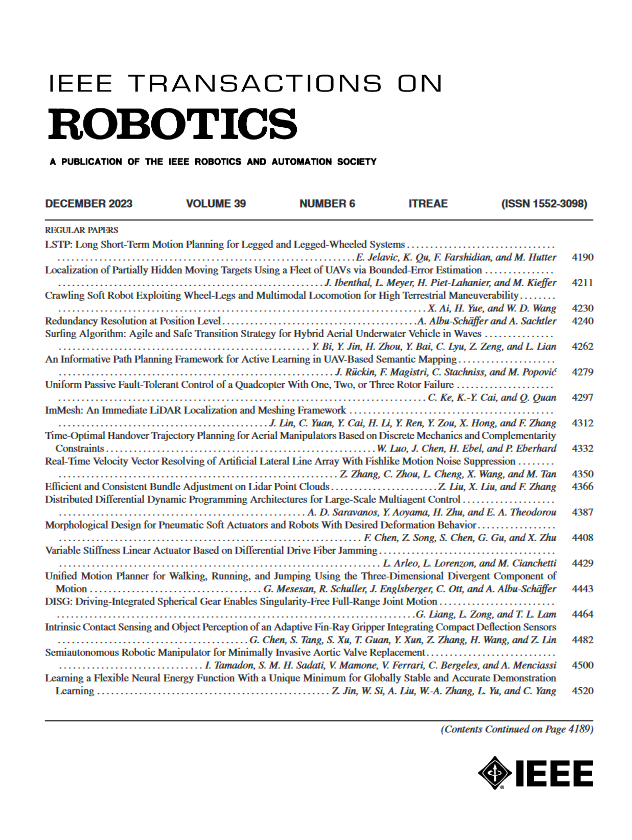Design, Control, and Evaluation of a Novel Soft Everting Robot for Colonoscopy
IF 10.5
1区 计算机科学
Q1 ROBOTICS
引用次数: 0
Abstract
Colonoscopy is a medical procedure used to examine the inside of the colon for abnormalities, such as polyps or cancer. Traditionally, this is done by manually inserting a long, flexible tube called a colonoscope into the colon. However, this method can cause pain, discomfort, and even the risk of perforation. To address these shortcomings, advancements in technology are needed to develop safer, more intelligent colonoscopes. This article presents the design, control, and evaluation of a self-growing soft robotic colonoscope, leveraging the evertion principle. The device features a tube with an 18 mm diameter, constructed from stretchable fabric, which grows 1.6 m at the tip under pressurization. A pneumatically driven, elastomer-based manipulator enables omni-directional steering over 180° at the tip. An airtight base houses motors and spools that control the material and regulate growth speed. The robot operates in two modes: teleoperation via joysticks and autonomous navigation using sensor inputs, such as a tip-mounted camera. Thorough in-vitro experiments are conducted to assess the system’s functionality and performance. Results illustrate that the robot can achieve locomotion in confined spaces such as a colon phantom, while exerting contact forces averaging less than 0.3 N. Our soft robot shows potential for improving the safety and autonomy of colonoscopies, while reducing discomfort to patients.一种新型软式结肠镜检查机器人的设计、控制与评价
结肠镜检查是一种医疗程序,用于检查结肠内部的异常情况,如息肉或癌症。传统上,这是通过人工将一根叫做结肠镜的长而柔软的管子插入结肠来完成的。然而,这种方法会引起疼痛、不适,甚至有穿孔的风险。为了解决这些缺点,需要技术进步来开发更安全、更智能的结肠镜。本文介绍了利用旋转原理设计、控制和评估一种自生长软机器人结肠镜。该装置的特点是一个直径为18毫米的管子,由可拉伸织物制成,在加压作用下,其尖端会长1.6米。气动驱动,基于弹性体的机械手可以在尖端进行180°以上的全方位转向。一个密封的底座装有电机和线轴,控制材料和调节生长速度。该机器人有两种操作模式:通过操纵杆遥控操作和使用传感器输入的自主导航,比如安装在头部的摄像头。进行了彻底的体外实验,以评估系统的功能和性能。结果表明,该机器人可以在狭窄空间(如结肠幻影)中实现运动,同时施加平均小于0.3 n的接触力。我们的软体机器人显示出提高结肠镜检查的安全性和自主性的潜力,同时减少患者的不适。
本文章由计算机程序翻译,如有差异,请以英文原文为准。
求助全文
约1分钟内获得全文
求助全文
来源期刊

IEEE Transactions on Robotics
工程技术-机器人学
CiteScore
14.90
自引率
5.10%
发文量
259
审稿时长
6.0 months
期刊介绍:
The IEEE Transactions on Robotics (T-RO) is dedicated to publishing fundamental papers covering all facets of robotics, drawing on interdisciplinary approaches from computer science, control systems, electrical engineering, mathematics, mechanical engineering, and beyond. From industrial applications to service and personal assistants, surgical operations to space, underwater, and remote exploration, robots and intelligent machines play pivotal roles across various domains, including entertainment, safety, search and rescue, military applications, agriculture, and intelligent vehicles.
Special emphasis is placed on intelligent machines and systems designed for unstructured environments, where a significant portion of the environment remains unknown and beyond direct sensing or control.
 求助内容:
求助内容: 应助结果提醒方式:
应助结果提醒方式:


